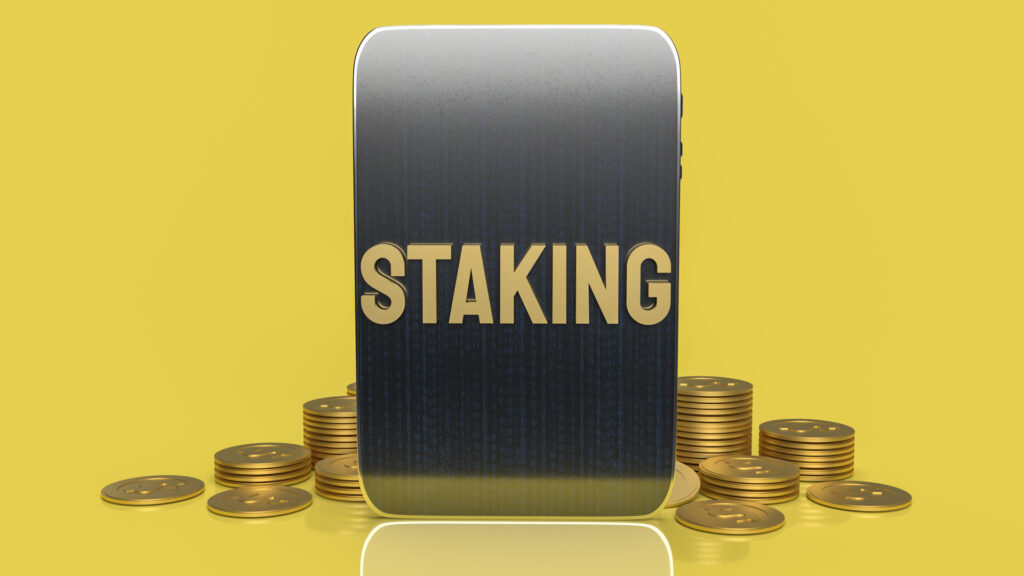What is crypto staking?
Staking is a way to leverage digital assets as a source of passive income without selling or transferring them to third parties. In the DeFi world, it is also often referred to as minting or forging.
What does it mean to “stake crypto”? Well, the easiest way to explain it is to compare staking to a savings account in a bank. The cryptocurrency owner puts their assets in a digital account and enters into a smart contract with a certain platform, under the terms of which they cannot dispose of them until a specific deadline expires. In this way, the assets are “frozen,” and new coins get generated in the process – this is the profit the cryptocurrency owner will receive after the specified stacking period expires.
Why do the platforms need it? First, it is how they ensure the stability of their blockchain and its development. After all, staking means that it enables the platform to mine new tokens. Moreover, it increases their number in circulation, helping to popularise the cryptocurrency and increase its value. Mining works similarly, but unlike it, staking does not require a significant expenditure of electricity, powerful equipment and technical knowledge of the user. Also, under certain conditions, the income from staking is often equal to the income from mining and certainly exceeds any interest rate modern banks offer.
How does staking work?

Not every cryptocurrency works on a blockchain with stacking technology. Nevertheless, if you own one that does, you can make it “work,” which will bring you a reward equivalent to a percentage rate. However, what exactly is this work and what happens to the cryptocurrency during staking?
Cryptocurrencies that allow users to engage in staking use a so-called consensus mechanism called Proof-of-Stake. Its purpose is to verify the security of all transactions and guarantee their success without the involvement of a bank, payment system, or any other intermediary. As soon as you let your cryptocurrency into stacking, it becomes part of a continuous Proof-of-Stake process.
In stacking, only one validator (network member) gets chosen to add a block to the blockchain, and accordingly, they receive a certain amount of cryptocurrency in return. The terms and requirements for this process vary from project to project. Regardless, the point is always the same: users bet on being selected to conduct the transaction for a fee. Basically, it is a competition for which the direct participation of validators is not even required – everything happens automatically. Coins placed in the wallet (i.e., the bid) are needed to guarantee the procedure's legitimacy because if the new block turns out to be untrustworthy, the user loses their share in the network.
When selecting a validator, the network evaluates their bid's size and the time that bid has been placed for. The more of both, the higher the chance of that validator getting selected – therefore, the higher the income. That is why staking recommends placing high bids with a long-term perspective of one to two years to maximise your profits.
The pros and cons of staking crypto

Crypto staking has several unique advantages that distinguish it from alternative ways of mining cryptocurrency:
- There is no need to purchase sophisticated equipment. All you need for staking is a smartphone with the app installed on it provided by the blockchain.
- Low power consumption. Unlike Proof-of-Work, whose users consume as much electricity per year as the whole of Argentina, staking is very budget-friendly. That is why it is also environmentally friendly, and is approved by governments worldwide.
- High interest. One rate allows you to earn 20% per annum in some blockchains! So, this is a reliable and profitable way to protect your money from inflation and maybe even multiply it.
However, staking also has disadvantages:
- The instability of cryptocurrency prices. If the fall in the rate exceeds the interest you earnt, you will not earn anything (but you will not lose anything either).
- Time limits. Many blockchains allow the freezing of coins for one year or more, which is not suitable for everyone. Today, there are few projects with short-term stacking on the market as it is considered unprofitable.
Staking rewards
Stacking fees incentivise network participants to allow blockchain to work with their cryptocurrency. Each blockchain sets its amount of crypto remuneration for checking and adding one transaction block. When you bid and the network selects you, the staking reward is credited to your wallet after the block gets verified. However, it usually becomes available for further use at the same time as the bid, i.e., after the end of the smart contract period.
How to stake crypto

Starting your own cryptocurrency stake is much easier than becoming a miner. Just follow the instructions:
1. Purchase a cryptocurrency that uses a consensus algorithm
That is, Proof-of-Stake, not Proof-of-Work, on which, for example, the popular Bitcoin works. Only such cryptocurrency will you be able to place in the form of bids to earn interest. You'll find a list of available PoS-based cryptocurrencies below. One caveat, however: ensure you carefully examine each one's offerings. All cryptosystems are different! Check the size of bids, the acceptable terms of staking, the blockchain's encryption algorithms, and the cryptocurrency's availability on major international exchanges like Coinbase.
2. Transfer the purchased currency to a blockchain wallet
Some exchanges offer their own staking programmes, so you can simply go to the adjacent section of the site, select the number of coins you want to bid, and start the process without visiting another site. However, if the exchange does not have such programmes, you will have to transfer funds to a cryptocurrency wallet. It can be both hot (i.e., digital, continuously connected to the Internet and tied to a specific platform) and cold (it is a physical medium without a direct connection to the network, which you can even carry in your pocket, like a flash drive).
Transferring currency to a cryptocurrency wallet is as easy as pie. As soon as you get one, click “Deposit Cryptocurrency” and specify what kind of cryptocurrency you want to transfer. In response, the wallet will generate your unique address. Next, go to your exchange account, click “Withdrawal”, paste the generated address into the appropriate field, and job done!
3. Join the staking pool
As in the case of mining, joining a staking pool is a much more profitable, reliable, and a faster way to make a profit than mining tokens alone. Additionally, it saves you from figuring out which bid works for a particular cryptocurrency and how. In a pool, you combine your bets – staking coins – with other traders to increase your distribution odds and share the resulting reward in shares proportional to the bids made.
However, before you join a particular pool, carefully examine it according to three criteria:
- Stable servers. If the pool servers are disconnected, the pool, respectively, does not work, and you will not receive any remuneration. Therefore, the more stable the pool network is, the fewer problems you may have with withdrawing your funds in the future.
- Moderate fees. Pools always charge a percentage of their traders' fees, and that's fine. However, the lack of fees is just as suspicious as fees above 10%. Ideally, they should be 2% to 6% at most.
- The size-to-price ratio. The smaller the pool, the less chance that the network will choose it to check the block, but at the same time, the greater the potential reward. After all, having fewer participants in the pool means you won't have to share the reward with too many people. Simultaneously, however, small pools tend to have more frequent issues with server instability. It explains why you should pick a medium-sized pool because in pools too large, you're unlikely to achieve a decent profit.
So, as soon as you choose a pool, all that remains is to deposit your money in it through a wallet – and the stacking will start automatically.
Is crypto staking safe?

Yes! Staking is an entirely safe and legal way to make money from cryptocurrencies and there is no greater risk than with its alternative, mining. In the process of staking, your money always stays in your wallet and does not go anywhere. It is freezing your funds in your account, not transferring them. However, you will still not be able to interact with the cryptocurrency in any way for a fixed period. Its duration will depend on the terms of the blockchain or the pool. It can last for one day or for as long as several years.
Here are some questions you should ask yourself if you are in doubt about starting a staking process:
- Are you ready for price changes? The cryptocurrency market is quite volatile, so it is tough to predict the price over the long term. If the price suddenly drops or, on the contrary, skyrockets, you won't be able to withdraw and use the cryptocurrency in any case. Sometimes, the cryptocurrency price drops by 20% during the staking period compared to the original purchase price.
- How soon can you get access to your money? If you suddenly need it, the cryptocurrency won't be available. So, make sure you know what you'll be living on before the staking period expires, and set aside a safety cushion!
- Do you believe in this cryptocurrency? Since staking is typically a long-term investment, you should carefully approach the choice of cryptocurrency. Moreover, please consider its history, prospects, white paper characteristics, reviews, and experiences of other validators.
- Have you explored other ways to make money from cryptocurrencies? Just like crypto itself, staking is not suitable for everyone. You may not need it at all to create a source of passive income. Cryptocurrency lending, for example, is just as good a source of passive income where you don't have to work hard to earn. So, ensure you are familiar with all the alternatives before resorting to staking. The main thing is to choose not the most profitable for everyone way, but the most beneficial one for you personally.
Proof-of-Stake (POS)

Proof-of-Stake is the consensus mechanism by which blockchain transactions get conducted and their security guaranteed. Using Proof-of-Stake means that all nodes in the network must approve the addition of a new block to the blockchain ledger, thereby confirming that the transactions are valid.
However, unlike Proof-of-Work (i.e., mining), this does not require users to solve complex mathematical equations with high-performance hardware. Instead, validators put their own cryptocurrency to work by placing bids and thus provide the same support blockchain miners provide through hashing.
Today, Proof-of-Stake is considered the most promising and preferred method of cryptocurrency mining, chosen most often by new start-ups and projects focused on long-term development.
The best crypto coins to stake
As mentioned above, you can only start staking cryptocurrencies that work on the Proof-of-Stake mechanism. And such cryptocurrencies include:
- Ethereum is one of the largest cryptocurrencies, ranking second on the crypto market after Bitcoin. Currently, Ethereum has just finished implementing the transition from PoW to PoS by launching its updated project and the ETH 2.0 token. According to the developers' idea, such Ethereum staking will reduce energy consumption and thus increase its attractiveness to investors.
- According to experts, Cardano is the most environmentally friendly cryptocurrency in the world. It is out of concern for nature that it uses Proof-of-Stake.
- Solana is a well-known blockchain with scalability and low fees.
Similarly, by the way, you can stake NFTs. For example, popular avatars are CyberKongz or Mutant Cats.
The best platforms for staking

Crypto staking platforms furnish an opportunity for the user to make money without directly participating in the earning process. Many of them have the most straightforward functionality that allows you to start staking with a click of the mouse and guarantee risk protection. The following platforms are thought of as the most proven and effective as of December 2022:
- Coinbase is a golden classic that's great for beginners;
- Gemini is a platform that also specialises in cryptocurrency lending;
- Binance offers the most flexible rates;
- Kraken also works with NFTs;
- MyContainer - works even with the rarest and “exotic” cryptocurrencies.
On all of these platforms, you will find a staking calculator to help you calculate the potential profits of your bids.
Is crypto staking worth it?
Yes, if you are aware of all the risks we've discussed and are confident that the benefits and features of staking are right for you. Since the amount of reward generated depends on the size of the bid you place and the pool you join, you must get prepared for the fact that you can't make a quick profit. Staking is for the patient.
Consider the terms of the crypto exchange or staking platform and the schedule by which the payments get distributed. It should definitely make you regular money. Moreover, it should bring you an income totalling at least 3 to 7% per annum (and hopefully more). What’s more, as a validator, you will ensure a stable income, independent of the influence of third parties, and preserve money and nerves.